The gnomes and creatures that inhabit Tim Tindle’s ceramic sculptures are sparked by his two young daughters’ imaginations. Tindle calls his style “narrative sculpture.”
“The pieces are like found objects that make you wonder, ‘What’s behind that door?’ You look at it and your brain starts making up stories.
“Like a knot at the bottom of a tree could be a gnome door, or a sunbeam coming in the window could be fairies,” Tindle says.
Tindle and his wife, Amy DePierre, are Wheat Ridge residents since 2001. Their daughters are ages 5 and 7. He grew up in Englewood and says that Wheat Ridge reminds him of old Englewood because of its “hometown vibe.” A self-described “earth person,” Tindle gardens and bakes bread.
“It’s important to my family to be involved with the people around us in a positive way, like growing local food.”
Tindle says he was “born an artist” and is mostly self-taught. He started painting with watercolor and drawing in pen and ink when he was young. But the life of an artist hasn’t been easy.
“I fought hard to hold onto it,” he says. “I have my up and down phases. Sometimes art is not a priority, but it always comes back around when I get into a quiet space and ask myself what I need to do with my life.
“‘Do your art like your life depends on it, because it does,’ is what I learned from Bob Ragland, a Denver artist who was a prolific painter and a teacher. He also taught me that making a living in art requires spending 50 percent of your time on marketing. Great wisdom. I’ve learned from many mentors, especially the ‘old wise guys.’”
Tindle draws inspiration from various sources to create his sculptures.
“I try to avoid symbolism, but I use the hobo alphabet in some of my pieces. The hobo alphabet was a code among travelers who hopped trains during the Depression, moving from town to town to find work. The code told other travelers where it was safe to camp and where they might get food or work: messages like ‘safe home,’ or ‘nice lady lives here.’ If you’re looking at one of my pieces you know it’s a symbol, but because it’s not an occult symbol or a rune, you might not recognize it. I like using the hobo alphabet because it’s uniquely American.”
He started working in clay in 2007, when his wife enrolled them both in a beginning clay class at the Arvada Center as a date night gift.
“I continued on with it and I fell in love with clay. Clay is an ancient medium, here since the first humans, found in every archaeological dig. When get clay in my hands, I can feel the ancestors.
“There’s also a sense of chaos because it can crack or explode in the kiln. It taught me to let go of control.”
Tindle says his creative process is often spontaneous.
“A lot of my style is free-flowing. I sit down with a block of clay and I don’t know where it’s going. I roll it around in my hands and watch it take shape, like seeing animals in the clouds. I let the clay be what it wants to be. Other times I start with a specific idea to work on, like a pot with a door. I go through phases, like octopuses or gnomes.
“I practice my technique so the piece will survive the fire. It can’t be too thick or too thin. It’s great because I figure out how to get the most out of the medium. I’m always learning more about glazes.”
He creates most of his pieces at the Arvada Center’s ceramic studio, using high-fire ceramic fired to cone 10 – more than 2,000 degrees.


“Firing the clay to a certain temperature makes it harder than terracotta. It turns clay into stone so it can stay outside without crumbling like terracotta. Most of my pieces are made to withstand the weather.”
Tindle teaches art at area elementary schools through Sweet Ridge Studios’ after-school enrichment program. He also teaches ceramics and other art classes at the Arvada Center, leading summer and Christmas break camps for all ages.
“My favorite are the parent/child classes. Parents often don’t have the time for creativity, so they get an opportunity to grow and get back to their little kid mentality. I love to inspire people to try new things and get creative.”
Tindle also makes coloring books and is in the process of writing a children’s book of stories.
His newest pieces are functional narrative sculptures including cups, bowls and plates. His future dreams include creating dioramas with clay, and on a larger scale, public art.
“It would be fun to create concrete sculptures for playgrounds around Denver.”
“I try to create from love, to align with the force that creates everything,” he said.
Tindle will sell his art at the Arvada Center’s spring pottery sale in May, and at Art on the Farm in Wheat Ridge this summer. He works with Wheat Ridge Creates, a city-assisted group focused on gathering creatives and growing the arts.
“Wheat Ridge Creates gives artists the opportunity to show at events like Art on the Farm and school holiday fairs,” said Tindle.
See Tim Tindle’s work on Instagram at @tindle_vibes.






